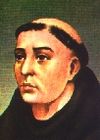- Toribio de Benavente Motolinia
-
Fray Toribio de Benavente (1482, Benavente, Spain- 1568, Mexico City) also known as Motolinia was a Franciscan missionary and among the first 12 clerics to arrive in New Spain in May 1524.
Contents
Life and times
He entered the Franciscan order as a young boy changing his family name Paredes to that of his birthcity Benavente, as was the custom among the Franciscans. In 1523 he was chosen to be among the first twelve missionaries to be sent to the New World.
After a strenuous journey he arrived in Mexico where he was greeted by Hernán Cortés. Upon riding through Tlaxcala the Indians commented on his ragged franciscan robes saying "Motolinia" which in the Nahuatl language means "He afflicts himself" or "He is poor". This was the first word he learned in the nahuatl language and he took it as his name. He was named guardian of the Convent of San Francisco in Mexico City where he resided from 1524 to 1527.
From 1527 to 1529 he was in Guatemala and Nicaragua studying the new missions in that area. Back in Mexico he stayed at the convent of Huejotzinco near Tlaxcala, where he had to help the natives against the abuse and atrocities committed by Nuño de Guzmán. He suggested to the native leaders that they complain to the Bishop Juan de Zumárraga about Guzmán but the latter accused him of trying to instigate a revolt among the Indians against the Spanish sovereignty. In 1530 he went to the Convent of Tlaxcala and contributed in the foundation of the City of Puebla de Los angeles. With Franciscan colleagues he travelled to Tehuantepec, Guatemala and Yucatán to undertake further missionary work.
Even though Motolinia protected Indians against the abuse of Guzmán he did not share the opinions of the Dominican Bartolomé de las Casas who saw the conquest and subjugation of the Indians as a crime and against all Christian morality. Motolinia believed that God would protect the Indians once converted and that the missionary work thus was more important than fighting the encomienda system and he remained a defender of the conquest, the encomienda system and the evangelization. In fact in a famous letter to Charles V of Spain he undertook a virulent attack upon Bishop Bartolomé de las Casas, intending to discredit him completely. He called him "a grievous man, restless, importunate, turbulent, injurious, and prejudicial" and even an apostate in that he had renounced the Bishopric of Chiapas. He furthermore advised the king to have him shut up for safe keeping in a monastery. In 1545 the encomenderos of Chiapas asked for him to come there to defend them against Las Casas but he declined, in the same way he declined a position as Bishop offered to him by the king.
Having founded many cloisters and convents in Mexico and supposedly baptized more than 400,000 Indians he retired to the Convent of San Francisco in Mexico where he died in 1568. He is remembered in Mexico as one of the most important evangelists.
Ethnographies
Motolinia is well-known for his two histories of the Aztecs:
- Historia de los Indios de la Nueva España which was not published until 1858, by Joaquin Garcia Icazbalceta.
- Memoriales, first published in 1903.
External references
Catholic Encyclopedia on Fray Toribio de Benavente Motolinia
Bibliography
- Lino G. Canedo, "Toribio Motolinia and His Historical Writings", The Americas, Vol. 29, No. 3 (Jan., 1973), pp. 277–307
- Marion A. Habig, "The Franciscan Provinces of Spanish North America (Concluded)", The Americas, Vol. 1, No. 3 (Jan., 1945), pp. 330–344
- Doris K. Arjona, "The Twelve' Meet a Language Requirement", Hispania, Vol. 35, No. 3 (Aug., 1952), pp. 259–266
Catholic Church titles Preceded by
Alonso RancrelProvincial of the province of the Holy Gospel Succeeded by
Juan de GaonaMartín de Valencia · Francisco de Soto · Martín de Jesús · Juan Juárez · Antonio de Ciudad Rodrigo · Toribio de Benavente Motolinia · García de Cisneros · Luis de Fuensalida · Juan de Ribas · Francisco Jiménez · Andrés de Córdoba · Juan de PalosCategories:- 1482 births
- 1568 deaths
- People from Zamora (province)
- Franciscans
- Novohispanic Mesoamericanists
- Historians of Mesoamerica
- Aztec scholars
- Spanish Christian missionaries
- Roman Catholic missionaries
- 16th-century Spanish people
- 16th-century Mesoamericanists
Wikimedia Foundation. 2010.

